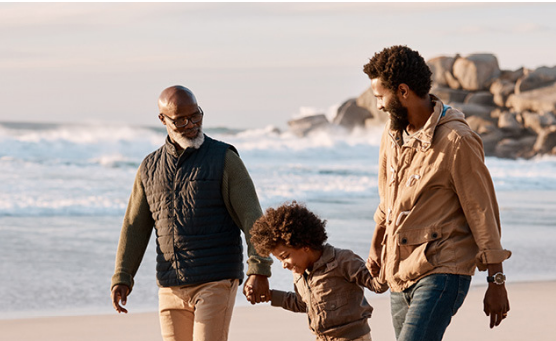Photos: John Hopkins\YouTube
In the following op-ed Joy Franklin, on behalf of the Men’s Health Network, speaks on the lifespan gap of between African-American men and white men and the efforts to promote healthier living and exercise to tackle the health disparities that Black men in particular face.
African-Americans could expect to live 14.6 fewer years than white Americans in 1900 but the gap between the lifespan of African-American men and white men was slightly smaller at 14.1 years.
By 2015, the gap for both sexes had shrunk to 3.4 years, based on Centers for Disease Control statistics, though the gap between the life expectancies for African-American and white men in 2015 was greater at 4.4 years, indicating that progress in closing the gap has been less for African-American men than women.
COVID-19, which has disproportionately affected Black and other minority communities, appears to have reversed the slow progress. CDC projections for 2020 show a gap of 6 years for both sexes, with African-Americans’ life expectancy at 72 years compared to 78 years for white Americans. However, the life expectancy gap between African-American and white men is projected to be 7.2 years. While there’s been some progress in closing the gap, much more needs to be done to address the systemic causes in society and in the health care system.
Poverty, environmental threats and racism, along with inadequate and unequal access to health care all contribute to health disparities that result in earlier mortality among African-Americans. These systemic problems also contribute to individual factors, such as higher rates of obesity and hypertension, that lead to higher rates of heart disease, stroke and type 2 diabetes. The good news is that these individual factors can be modified by behavioral changes.
In 2014, the Patient Centered Outcomes Research Institute (PCORI) funded a study designed to determine if a program called Active and Healthy Brotherhood (AHB) would help Black men increase their daily exercise in an effort to reduce their risk of chronic disease. The research team also looked at how AHB affected other healthy behaviors and signs of health problems, such as high blood pressure and blood sugar.
Poor diet and lack of exercise that result in obesity and/or hypertension contribute to a daunting list of health destroyers that undermine quality of life. In addition to type 2 diabetes, heart disease and stroke, these include gallbladder disease, many types of cancer, osteoarthritis, sleep apnea and mental disorders such as depression and anxiety. Obesity also puts people at higher risk of severe illness from COVID-19, according to the CDC. In fact, those who are obese, compared to those with a healthy weight, are at increased risk of dying from all causes of mortality.
For the PCORI-funded study, conducted by Winston-Salem, N.C.-based Gramercy Research Group, researchers had hoped to recruit 400 African-American men, but were only able to enroll 333 from four North Carolina counties. Those recruited, who had an average age of 51, didn’t exercise often or eat enough fruits and vegetables, or they had diabetes, high blood pressure, or heart disease. They were divided into two groups.
The AHB group received a basic education session followed by 16 weekly sessions which focused on being active, eating healthy, and managing stress. The sessions included small-group activities that allowed the men to discuss health goals and support each other. After AHB ended, the men received three phone calls to talk about goals and ways to achieve them. A second group received the basic education session and information about improving healthy behaviors, but did not participate in follow-up sessions.
Study participants wore fitness trackers which measured daily exercise and completed surveys about healthy behaviors at the start of the study and at follow-up visits 6 and 12 months later.
Researchers found improved nutrition-related behaviors in the AHB group compared to the control group, but no improvements in daily physical activity. While the study’s findings were limited both because of under-recruitment and because only 218 of the 333 completed the final survey, there is an obvious need to continue this type of research.
Men’s Health Network reported that a recent survey found that men want to take control of their health. In the survey, 85 percent said they wanted to take charge of their fitness and 84 said they wanted to take charge of their diet and nutrition. The results were not broken out by race. But the survey indicates that this is an area where men want to be empowered.
One conclusion of the study was that because African-American men have historically been a relatively understudied group, little is known about effective strategies for engaging them in research and improving health-related behaviors. This study contributes to that knowledge. Hopefully, it will provide useful insight to support further research into ways to empower African-Americans to lead healthier lives and continue to reduce the life expectancy gap.
About Men’s Health Network:
Men’s Health Network (MHN) is a national organization whose mission is to reach men and their families where they live, work, play, and pray with health prevention messages and tools, screening programs, educational materials, advocacy opportunities, and patient navigation.
MHN is composed of physicians, researchers, public health workers, other health professionals, and individuals. MHN authors regular columns on men’s health in medical journals and is the major resource for men’s health information for the mainstream media.
Men’s Health Network is known as the leading authority on men’s health, with a Board of Advisors totaling over 800 physicians and key thought leaders. With a network of chapters, affiliates, and health partners, MHN has a presence in every state and over 30 countries.






